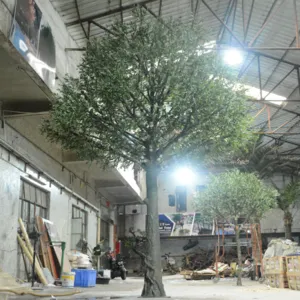
Olive trees, as a plant with a long history and rich cultural heritage, are not only widely planted outdoors, but can also be cultivated indoors. However, not all varieties of olive trees are suitable for indoor environments. When choosing an olive tree to grow indoors, it’s important to choose a variety that’s suitable for your home’s conditions. Olive trees can be challenging to grow indoors, but some varieties are better suited to indoor environments. Due to their compact size, the olive trees best suited for indoor growing are usually dwarf or semi-dwarf varieties. What is the best olive tree for indoors?

Olive trees suitable for indoor cultivation:
1. Arbequina: Arbequina olive trees are one of the most popular choices for indoor planting. It is a small, compact tree that is ideal for container gardening. It produces small, flavorful olives that thrive in warm, sunny indoor conditions.
2. Arbosana: Similar to Arbequina, Arbosana is a dwarf variety that produces small olives. Due to its manageable size, it is an excellent choice for indoor gardening.
3. Picholine: The Picholine olive tree is a semi-dwarf variety that is ideal for indoor growing. It produces small green olives with a pleasant aroma.
4. Kalamata: The Kalamata olive tree is a larger dwarf variety known for its deep purple olives, known for their rich flavor. While it's sturdier than some other indoor options, it can still be kept in a container with proper pruning.
5. Frantoio: The Frantoio olive tree is a compact variety that produces olives suitable for the production of olive oil. Its manageable size makes it a good choice for indoor cultivation.
Tips for growing olive trees:
Next, let’s take a look at the tips for growing olive trees. First, choosing the right soil is crucial for the growth of your olive tree. Generally speaking, soil that is loose and not too sticky is good for olive tree root growth. When it comes to watering, just keep the soil moist; overwatering may cause root rot. In terms of fertilization, nutrients such as nitrogen, phosphorus, and potassium can be appropriately added to help olive trees grow. In addition, pest control is also an important task. Check leaves and branches regularly, and treat any pests and diseases in time if found.
Temperature is a key factor when it comes to the environment in which olive trees grow. The suitable temperature range is 15-25 degrees Celsius. Too high or too low is not conducive to the growth of olive trees. In addition, light is also an important factor affecting the growth of olive trees. In an environment with sufficient light, olive trees can perform photosynthesis better and promote growth. Humidity is also a factor that needs attention. An environment that is too dry or too humid is not conducive to the healthy growth of olive trees.
In short, olive tree varieties suitable for indoor cultivation include green olives, red olives, and olive trees. During the planting process, you need to pay attention to selecting suitable soil, mastering watering techniques, rational fertilization, and doing a good job in pest and disease control. In addition, suitable temperature, light and humidity are also key factors to ensure the healthy growth of olive trees. I hope this article can provide some useful reference and guidance to friends who like to plant olive trees.